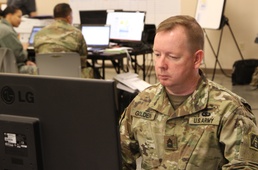
CAMP ATTERBURY, Ind. — In perhaps the most prominent fixture inside the tactical operations center (TOC) here, an aircraft symbol accompanied with the caption “VEHICLE CRASH” suddenly emerges on a large electronic map. A flurry of radio chatter and conversations between the TOC personnel subsequently follows, and everyone collaborates with each other to resolve the crisis. Although this is not a real-world event that just occurred, the members of this multi-service organization are training as if it were rooted in reality.
Known as the Defense Coordinating Element (DCE) Region VII, Kansas City, Missouri, this section acts as a liaison between Task Force 76 (TF-76) and federal agencies responding to a disaster. TF-76 and Task Force 46 are subordinate emergency response forces participating in Exercise Vibrant Response 2017 (VR-17) here, April 17-May 13. TF-76 falls under the Reserves 76th Operational Response Command, Salt Lake City, Utah. TF-46 is part of the 46th Military Police Command, Lansing, Michigan. Both task forces and the DCE fall under operational control of U.S. Army North (ARNORTH), Fort Sam Houston, Texas.
As stated by Army Col. Eric McGraw, the chief Regional Emergency Preparedness Liaison Officer (REPLO), DCE Region VII, the DCE does not engage in command and control processes, but instead performs intermediary functions between state and federal agencies to determine Department of Defense (DOD) level of involvement and usage of Title 10 (active-duty and Reserve branches of the U.S. military) in times of manmade and natural disasters.
“When an emergency happens, the governor and the President make the declaration of emergency,” said McGraw. “The governor then works with the state for capabilities that the states’ and National Guard cannot provide. The (EPLOs) help with the planning process and assist state governors in addressing their catastrophes, and then we can start to move our units in to address whatever their shortfalls and capabilities gaps are.
“We also have state EPLOs (SEPLOs) that are the connective tissue and linkage to the states,” said McGraw. “Then we have the regional EPLOs (REPLOs), in which we work with the DCE core team and also work closer with FEMA (Federal Emergency Management Agency). So because of all of these different moving pieces and parts, the DCO and DCE is critical in maintaining situational awareness and make sure any civilian entity is able to get their assets and resources.”
To facilitate the coordination of responding Defense Department units throughout the United States, the DCE Region VII employs the Semi-Automatic Ground Environment (SAGE) system, a multipurpose computer network that utilizes radar data to pinpoint personnel and asset locations with respective status updates displayed on maps.
“The SAGE system gives our Defense Coordinating Element the ability at any given time to look at several different viewing aspects of everything that’s going on,” said Master Sgt. Jeffrey Golden, the operations noncommissioned officer for the REPLO, 209th Regional Support Group, Kansas City. “It’s essentially an overall picture of where all of the mission assignments and units are at, the boundaries for (responding task forces), detonation sites, and subordinate units are located on the map.”
According to McGraw, the DCE’s training objectives are to have all staff officers who are mainly composed of senior noncommissioned officers and field-grade officers to cross-train so they can perform a lot of different functions, such as information awareness, effective and timely coordination with liaison officers (LNOs) and their TF-76 subordinate units, mission analysis, and cost assessments.
In addition to Army active-duty, National Guard, and Reserve units, other military branches of service play an integral role with DCE operations as well.
“The DCO is, by doctrine, an Army colonel, but the other services participate because of our knowledge and capabilities that we bring to the table,” said Air Force Col. John Bostwick, the Air Force REPLO. “So in this exercise for example, we can provide Civil Air Patrol capabilities that are available, while the Navy can bring maritime forces that are also available and can be brought to the disaster in support of our federal and state partners.”
ARNORTH conducts the VR training exercises annually to validate and confirm the capability of federal response forces to meet the expectations of the nation in times of crisis. As one of the largest confirmation exercises that the DOD conducts for its multi-service, specialized response forces, over 5,000 personnel from more than 40 locations in the U.S. have been taking part in VR-17 and its linked exercise Guardian Response 17.
“They have a great complex here at Camp Atterbury,” McGraw said. “These units have enhanced levels of readiness, enhanced levels of training, and this is really a big event where commanders get to (achieve) their training objectives.”